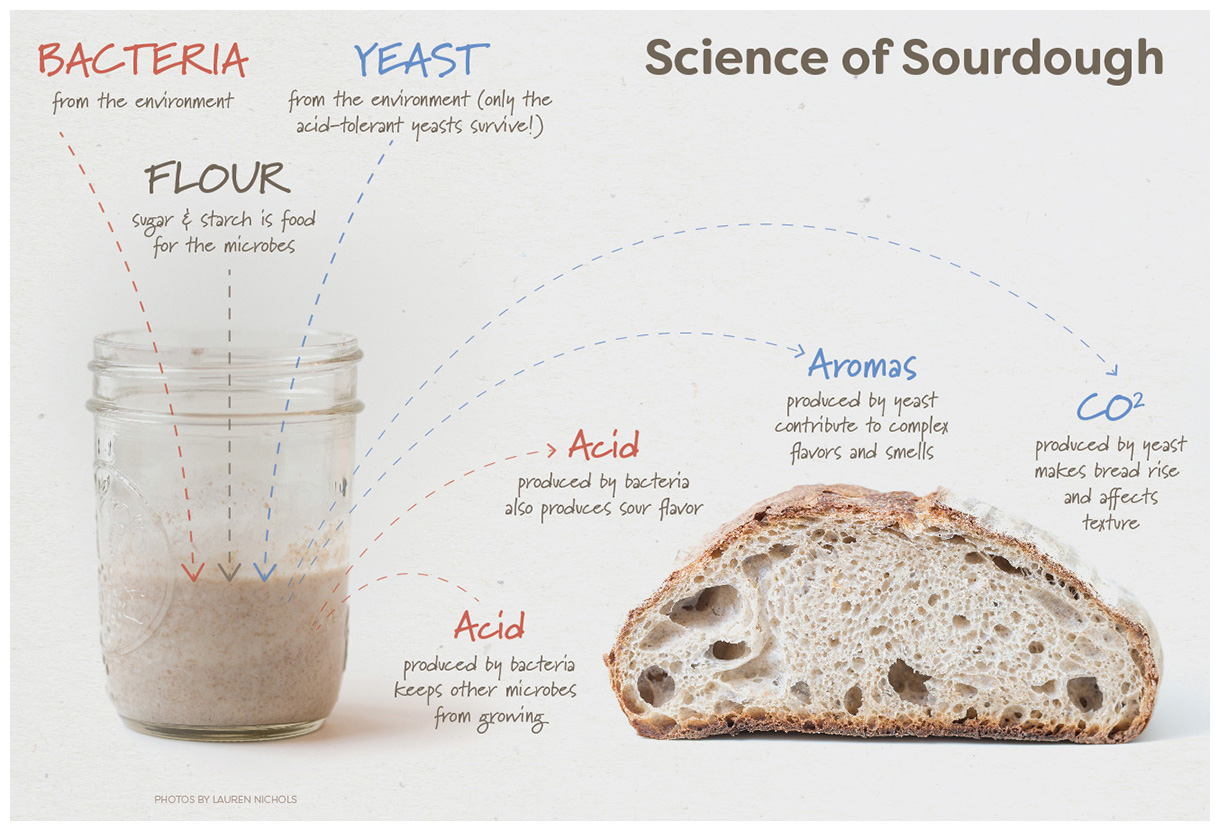Sourdough Basics
Want to start making sourdough bread? I decided to compile this sourdough digest to help people understand the basics of sourdough. Many people these days are spending more time at home and looking for something new to do. There are countless of instagram and facebook pictures displaying people’s wonderful overflowing starter. A few months ago, during Covid lockdown, you could not get any bread flour at the grocery stores and all bread making supplies on Amazon were back-ordered. Everyone seemed to be taking up sourdough bread making during the pandemic.
Making sourdough bread is very rewarding but can be somewhat daunting. However, with an understanding of the basics of sourdough, it will be a less intimidating. I started my sourdough adventure more out of a need rather than a desire after being diagnosed with pre-diabetes. After doing extensive research, I was hooked because of what I learned as well as seeing results in my family and friends with health challenges. Many of my sourdough recipes incorporate both ingredients and techniques that maximizes nutrition and minimizes gluten and carb. to make the end product healthier. I have organized this page to hopefully give you a comprehensive overview of the basics of sourdough.
Why Sourdough?
What is sourdough?
Sourdough is a natural leavening agent used for making breads. A ‘starter’ is composed of fermented flour, water, micro-organisms, lactic acid bacteria and yeasts naturally present in the flour, air and on your hands! According to the Puratos sourdough library, over 1100 strains of micro-organisms have been recorded. As a result, natural starters produce breads that have unique flavors depending on the micro-organisms makeup and the environment in which they thrive. Many Americans think sourdough dates back to the Gold Rush when the Boudin family started to produce the famous San Francisco Boudin sourdough bread. Research shows that sourdough can be traced back to Ancient Egyptian civilizations around 1500 BC. I was fascinated by this article on yeast and lactic acid bacteria in sourdough. Basically, lactic acid bacteria is abundant in sourdough than in commercial yeast and its presence as well as the sourdough bread making technique has many benefits.
Benefits of sourdough
Some people like sourdough because of the flavor, texture or nutritional benefits. For me, I had to do research to determine whether this whole sourdough thing was worth the time and effort and my findings were eye opening.
Unique flavor profiles
-
Because sourdough bread is made from a “live” starter whose flavor profile is dependent on its environment, these breads have their own unique and interesting taste. The longer the starter ferments, the more sour the dough. So, as a baker, you can decide and adjust the tanginess of your bread just by fermenting your dough longer. There have been many scientific studies done where the base was the standard bakers yeast bread compared to sourdough breads. NONE of the participants chose the breads made with bakers yeast for the taste and texture.
More nutritious
-
LactobacillusAs mentioned above, sourdough starter is made up of active bacteria and yeasts. The most common bacteria found in sourdough all over the world is lactobacillus or lactic acid bacteria (LAB). What does the presence of lactobacillus do in the bread? Most flours (wheat bran) contain phytic acid. This acid binds to important minerals like calcium, zinc, iron, and magnesium. It has been proven that LAB, during the fermentation process produces a more suitable pH condition for the degradation of phytic acid, freeing up the minerals and making them more available for our bodies to absorb. See Effects of natural starters used for sourdough bread in Morocco on phytate biodegradation.
-
The sourdough baking process
I underscore “during the fermentation process,” because it’s not just the mere presence of the lactobacillus in the starter, but it’s during this fermentation process when the phytates degrade. The longer the dough is allowed to ferment, the more time the lactobacilli have to do their work. I mention this because many commercial bakeries call their items “sourdough”. However, they just add an acetic acid to make their dough sour. They may also add both sourdough starter plus bakers yeast to speed up fermentation. So, read the labels! You may think you’re getting sourdough, but you’re not getting the benefits of sourdough. Homemade sourdough and some of my other sourdough recipes take over 12 hours to make. Most of that time is in the proofing (fermentation) of the dough. This is an important aspect of the recipe as this is when all the bio-chemical activity is occurring. I also gleaned from my readings that phytate biodegradation happens the most at 25 degrees Celcius or 77 degrees Fahrenheit. So, keep this in mind when doing bulk fermentation.
Lower glycemic index
- There is an interesting study on Sourdough fermentation as a tool for the manufacture of low-glycemic index white wheat bread enriched in dietary fibre. I tried to do this experiment myself in my own kitchen and compared my blood sugar levels after eating my sourdough bread and store bought bread. The results were consistent with that of the study. I had a lower blood sugar level after eating sourdough vs. store bought regular bakers yeast bread.
Lower gluten
- Another scientific study that was done proved that lactobacillus does decrease the amount of gluten in the bread. Although many studies show conflicting results as to whether sourdough breads could be considered gluten-free, I would say that sourdough breads are acceptable for people who are gluten intolerant, but not for those who have Celiac disease. This study was interesting because it mentioned that those gluten-free breads that people buy may help if you have Celiac disease, but the starches that make up the gluten-free “flour” is void of minerals and nutrients. Something worth thinking about! After pouring over copious studies and thinking about the nature of sourdough and its interactions with its environment, I realize how most baked goods can be tweaked in ingredients and technique to not only lower the glycemic index and gluten but also increase the nutritional content of the end product. This however, does require more time in the baking process, but well worth it for your health’s sake.
Sourdough Basics
Breadmaking 101 Class
Sourdough Glossary
This sourdough glossary will help you understand some of the terminology used
Essential utensils and tools for sourdough baking
Here are some essential utensils and tools for sourdough baking. These basic
Bread Math: Baker’s Percentages
Baker’s percentages and hydration percentages are two math concepts that are helpful
Understanding sourdough: adapting to the environment
Environment It took me a while to figure out how my environment
Maintaining the starter, making the levain
What is a starter? What is a levain? Some recipes use the
Making the bread dough
Making GOOD and healthy sourdough bread is a labor of love. It
Scoring your sourdough
Many people think that scoring your sourdough is just for aesthetic purposes.
Sourdough starter for the home baker
Many sourdough starter recipes out there are derived from professional bakers who
On-demand video tutorials
1
INTRO TO SOURDOUGH BAKING. WHAT IS IT AND WHY EAT IT?
This intro video explains what is sourdough and what are some of the health benefits of sourdough.
2
ESSENTIAL EQUIPMENT
This intro video explains the essential tools and utensils for successful sourdough bread baking.
3
BREAD MATH
Two basic math concepts everyone should know! Bakers’ percentages and hydration. Understanding bread math allows you to be creative with ingredients while ensuring that the bread is edible!
4
ADAPTING TO THE ENVIRONMENT
This video explains how your environment and factors such as temperature, time and humidity can effect the outcomes of your soudough bread. Understanding how sourdough works and being able to make the necessary adjustments to your sourdough process will ensure better bread outcomes.
5
MAINTAINING THE STARTER, MAKING THE LEVAIN AND MORE…
This video explains how to maintain a starter, make the levain and identify when the levain is ready for sourdough baking. I also share some tips on how to keep a minimal amount of starter to avoid housing mason jars of discard plus what to do with whole wheat flour when making the levain for optimal sourdough bread making.
6
MAKING YOUR FIRST SOURDOUGH BREAD
This video explains how to make the dough with tips on getting the most leavening, resulting in an airy bread with improved crumb and texture rather than a heavy, dense loaf. Autolyse, stretch-and-fold, bulk fermentation, shaping and proofing concepts are explained.
7
TIPS FOR SCORING AND BAKING YOUR SOURDOUGH LOAF
This video explains how and why one score’s sourdough. This video also covers sourdough terms such as the “ear” and “crumb” and tips to attaining a prominent ear and soft and airy crumb.
8
THE BEST WAY TO MAKE SOURDOUGH FROM SCRATCH
This video explains how your environment and factors such as temperature, time and humidity can effect the outcomes of your soudough bread. Understanding how sourdough works and being able to make the necessary adjustments to your sourdough process will ensure better bread outcomes.
9
THE BEST SOURDOUGH STARTER: COMPARE A 10 DAY VS. 5 YR STARTER
Side-by-side comparison between a 10 day and 5 year old starter. Which one is better? The results may surprise you!
Sourdough Techniques
How To’s
Stretch and fold sourdough by hand
Cutting and shaping your dough
Scoring your sourdough
Many people think that scoring your sourdough is just for aesthetic purposes.
Get the latest tip & trick!
Subscibe to my Youtube Channel
Sourdough Recipes
SOURDOUGH CITRUS FLAVORED HOT CROSS BUNS
Growing up in South Africa, Easter was a big thing. I went to an Anglican all-girls school that
SPROUTED BLACK LENTIL SOURDOUGH BREAD
In my “previous life,” before the internet, I sourced ingredients for food manufacturers and bakeries. One of my
DOUBLE CHOCOLATE SOURDOUGH COOKIES
I distinctly remember the first time I had a double chocolate chip cookie. It was at a cookie
SAVORY CHRISTMAS SOURDOUGH
I love Christmas. People tend to be in a joyful mood and many people wear their red and
HIGH-PROTEIN QUINOA SOURDOUGH BREAD
I developed this high-protein quinoa sourdough bread recipe by accident. I was visiting my daughter in Miami and
GOJI BERRY, CHIA, SESAME SOURDOUGH BREAD
I decided to develop this goji berry, chia, sesame sourdough bread as a superfood bread. Ever had goji
Get the latest scoop!
Never miss another new recipe or tip & trick.

